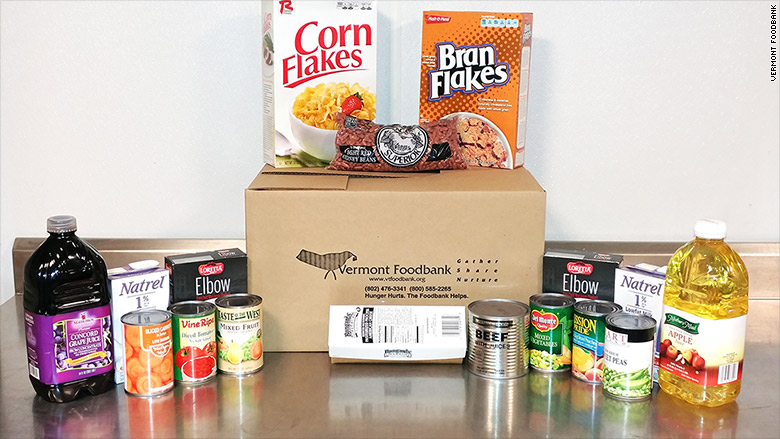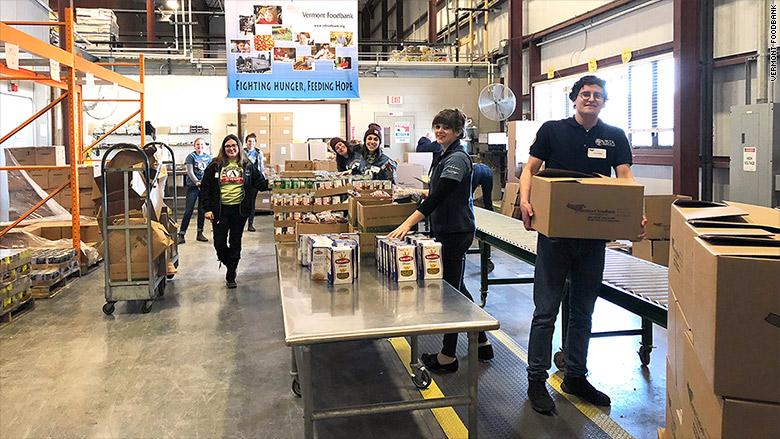
Providing food in a box to needy Americans is nothing new for the federal government.
It already supplies packages containing more than 211 million pounds of canned meats and fruits, juices, pasta, cereal and other nonperishable items that went to nearly 630,000 low-income senior citizens a month last year. Congress created the program in 1969.
That initiative is only a small part of the U.S. Department of Agriculture's commodity food program, which distributes a total of nearly 2.4 billion pounds of items to schools, food banks and other locations annually. The food is valued at $2.4 billion.
The idea of the government providing actual food to those in need was thrust into the spotlight this week after the Trump administration floated a radical overhaul of the nation's food stamp program as part of its fiscal 2019 budget. The proposal called for sending monthly food packages -- dubbed America's Harvest Box -- to the roughly 38 million Supplemental Nutrition Assistance Program recipients who would qualify, instead of half their cash benefit.
The Harvest Box concept was widely panned by consumer advocates and food retailers and is considered dead-on-arrival in Congress, which rarely adopts initiatives outlined in presidents' budgets. Also, there is little appetite among lawmakers for major welfare reform with a midterm election looming in November.
However, the USDA's existing food distribution efforts are viewed by government officials, consumer advocates and others as critical to helping hungry Americans.
Related: White House wants to deliver food to the poor, Blue Apron-style
Through the Commodity Supplemental Food Program, seniors with incomes at or below 130% of the federal poverty line -- or about $16,000 a year -- receive a monthly box of food worth roughly $50. It's enough to make about 25 meals per person. The USDA generally sends the items to food banks, social service organizations and other nonprofits, which boxes them for distribution to the elderly. The agency expects to boost the number of seniors receiving boxes to nearly 730,000 this year.

"Seniors love the program, and food banks love having this healthy food to distribute to the community," said Carrie Calvert, a managing director at Feeding America, an anti-hunger group that distributes supplies through a network of food banks, food pantries and meal programs nationwide.
In Vermont, for instance, some 2,400 seniors pick up their boxes at local food pantries, senior housing sites or food bank facilities, said John Sayles, CEO of Vermont Foodbank. Sometimes, the group sets up "tailgates" at parking lots, where the elderly can get their packages and other items such as fresh produce, bread and dairy.
"This is something seniors rely on," Sayles said.

Still, getting the food to seniors can be a challenge. Recipients can designate a representative to pick up their food for them, but some still fall off the program, particularly in rural areas, Sayles said.
Delivery issues are only one reason why experts say the Trump administration's plan would be problematic. It would be very difficult to scale up the senior food program to more than 38 million food stamp recipients. Plus, most enrollees prefer to buy their own food that meets their families' needs.
"It's not a very effective or efficient way for people to acquire their food," said Elaine Waxman, a senior fellow at the Urban Institute, of the boxed food proposal.
Related: The real story of food stamps
Food pantries have actually moved away from providing their clients with boxes or bags of food, she said. Instead, clients can often peruse the pantry's shelves to select what they need.
A large portion of the food at pantries also comes from a federal initiative called The Emergency Assistance Program. It distributes nearly 710 million pounds of food, including fruits and vegetables, eggs, milk, cheese, meat, pasta and other fresh and nonperishable items, to food banks and other community organizations. States set the income eligibility criteria.
This program is the single largest supplier for the Food Bank For New York City, for example, providing about half its items, said Margarette Purvis, the group's CEO. The non-profit provides enough food to make 62 million meals for 1.5 million New Yorkers each year through a network of food pantries and soup kitchens.
"TEFAP is the lifeblood of any food bank," Purvis said.
The USDA food distribution program is so important because it provides schools, food banks and other organizations with nutritious food that they might not otherwise be able to buy. For instance, schools can get a case of whole grain spaghetti for less than $10 from the government, said Chris Facha, president of the American Commodity Distribution Association, an industry group whose members distribute federal food. The same order would cost $30 if it were bought retail.
Child nutrition initiatives, such as the school lunch program, receive the largest share of federal food -- about 1.4 billion pounds of items valued at $1.6 billion annually.
"Some school systems couldn't afford the products the USDA offers," Facha said.


